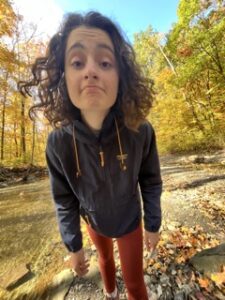I’m Lauren and I’m from Canton, Ohio! I’m a freshman majoring in Data Analytics (and thinking about adding geography as my second major!) I love to ski, kayak, hike, camp, and play tennis in my free time.g

I thought the Schuurman Ch. 1 reading was very interesting, especially because of all the applications of GIS it described. I especially thought the applications of water reservoirs and natural gas fuel lines were interesting. I was recently at ODNR, and I got to talk to them about how they use GIS and data for the Canalway and other water sources in Ohio as we are a part of both the Lake Erie and Ohio River watersheds. So, that portion of the reading really helped me tie that experience and the course together. On top of that, the reading also references some applications I never would have considered at the beginning – like its use in Starbucks stores! I also thought the history portion of the chapter was engaging. Learning about the history of using tracing paper and a light table was insightful into the very beginnings of GIS. I also found the part about the original resistance to GISystems and how it eventually became accepted without a second thought over time in the “black box” portion of the chapter. I also was surprised by the distinction between GISystems and GIScience. I did not know that there were two terms, but I appreciate the explanation of how both are important and work together. In this regard, I thought the notion that GIScientists constantly question the efficiency of the GISystems algorithms was super important. Algorithms can be so flawed when we make them even if we don’t notice them at first. In, high school I wrote a report on racism in the medical field and found that with organ donation algorithms, they favored white individuals over half the time. This always makes me think about how important it is to constantly keep an eye on and reevaluate the algorithms we make because often they include our own underlying biases, and we implement them anyways. Thus, I appreciate the aptitude of the book to explore this same notion and its truth for GIS algorithms.
The first GIS application I looked at was food deserts. Canton is a food desert, so I have always been interested in how to effectively view the impacted areas. Last year, a researcher from Ohio State came into one of my classes and showed us the maps he had compiled on Canton as a food desert. Thus, after I read this chapter and thought back to that class GIS came to mind. USC’s spacial science institute had a whole website on how they use GIS to study food desserts. They have mapped everything from the availability of produce and distance and rigor of the path it takes to get to a store. They cross-apply this with maps of income levels and people who own vehicles or other means of transportation. In one study done in Chicago, their researchers found that low-income neighborhoods had significantly less access to food and more poor-quality food compared to upper-class neighborhoods.
Another application I came across was for ski resorts. The application is called Snow Mappy and it was created when the founder decided she wanted a better way to view ski resorts than just a paper map or a sign at the top of the hill. Mappy uses GIS to map things like velocity, and skier speed on certain trails by level, density, and concentration of skiers on certain trails. The application can be used by skiers to track their location and different resources on the mountain as well as the resort itself to track its staff and decide if certain trails need to be added or changed based on where people ski. The map below is the map that displays skier density on trails based on skill level:

Cool applications. The need to be critical about technology is important (stuff covered in some other courses, but feel free to ask if you are interested). Even food deserts. This kind of mapping depends on a bunch of assumptions (what is a food source?) that often show us “deserts” where there are, well, not exactly deserts. Mostly, its a lack of large, chain grocery stores.